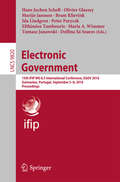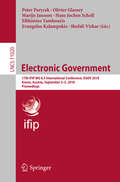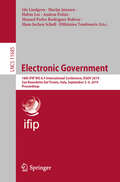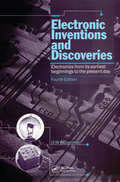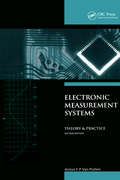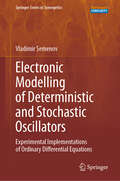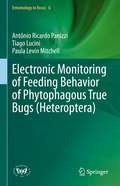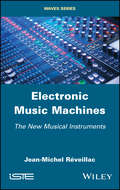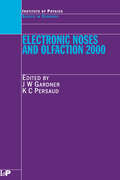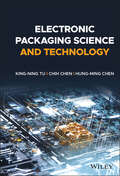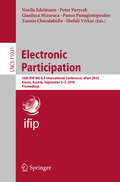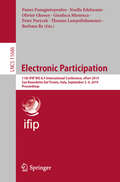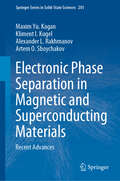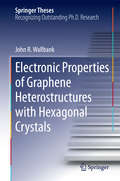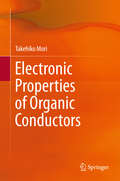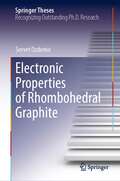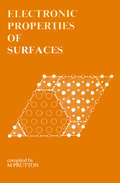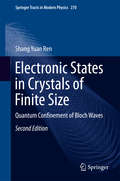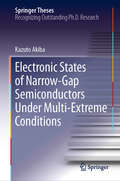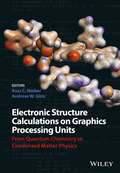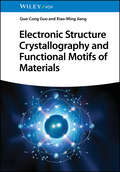- Table View
- List View
Electronic Government and the Information Systems Perspective: 8th International Conference, EGOVIS 2019, Linz, Austria, August 26–29, 2019, Proceedings (Lecture Notes in Computer Science #11709)
by Enrico Francesconi Andrea Kő Ismail Khalil A Min Tjoa Gabriele Anderst-KotsisThis book constitutes the refereed proceedings of the 8th International Conference on Electronic Government and the Information Systems Perspective, EGOVIS 2019, held in Linz, Austria, in August 2019. The 17 full papers presented were carefully reviewed and selected from 25 submissions. The papers are organized in the following topical sections: open data and open innovation; data-driven approaches in e-government; e-government cases – data and knowledge management; e-government theoretical background; and digitalization and transparency.
Electronic Government: 15th IFIP WG 8.5 International Conference, EGOV 2016, Guimarães, Portugal, September 5-8, 2016, Proceedings (Lecture Notes in Computer Science #9820)
by Efthimios Tambouris Maria A. Wimmer Delfina Sá Soares Tomasz Janowski Hans Jochen Scholl Marijn Janssen Bram Klievink Ida Lindgren Peter Parycek Olivier GlasseyThis book constitutes the refereed proceedings of the 15th IFIP WG 8.5 International Conference on Electronic Government, EGOV 2016, held in Guimaraes, Portugal, in September 2016, in conjunction with the 8th International Conference on eParticipation, ePart 2016. The 24 revised full papers presented were carefully reviewed and selected from 87 submissions. The papers are clustered under the following topical sections: foundations; benchmarking and evaluation; information integration and governance; services; evaluation and public values; EGOV success and failure; governance; social media; engagement; processes; policy-making; trust, transparency and accountability; open government and big/open data; smart government/governance/cities.
Electronic Government: 17th IFIP WG 8.5 International Conference, EGOV 2018, Krems, Austria, September 3-5, 2018, Proceedings (Lecture Notes in Computer Science #11020)
by Efthimios Tambouris Hans Jochen Scholl Marijn Janssen Peter Parycek Olivier Glassey Evangelos Kalampokis Shefali VirkarThis book constitutes the proceedings of the 17th IFIP WG 8.5 International Conference on Electronic Government, EGOV 2018, held in Krems, Austria, in September 2018, in conjunction with the 10th International Conference on eParticipation, ePart 2018.The 22 revised full papers presented were carefully reviewed and selected from 48 submissions. The papers are clustered under the following topical sections: General E-Government and Open Government; Open Data, Linked Data, and Semantic Web; Smart Governance (Government, Cities and Regions); and Artificial Intelligence, Data Analytics and Automated Decision-Making.
Electronic Government: 18th IFIP WG 8.5 International Conference, EGOV 2019, San Benedetto Del Tronto, Italy, September 2–4, 2019, Proceedings (Lecture Notes in Computer Science #11685)
by Efthimios Tambouris Hans Jochen Scholl Marijn Janssen Ida Lindgren Manuel Pedro Rodríguez Bolívar Habin Lee Andrea PoliniThis book constitutes the proceedings of the 18th IFIP WG 8.5 International Conference on Electronic Government, EGOV 2019, held in San Benedetto del Tronto, Italy, in September 2019, in conjunction with the IFIP WG 8.5 IFIP International Conference on Electronic Participation (ePart 2019) and the International Conference for E-Democracy and Open Government Conference (CeDEM 2019).The 27 revised full papers presented were carefully reviewed and selected from 64 submissions. The papers are clustered under the following topical sections: E-Government Foundations; E-Government Services and Open Government; Open Data: Social and Technical Aspects; AI, Data Analytics and Automated Decision Making; and Smart Cities.
Electronic Inventions and Discoveries: Electronics from its earliest beginnings to the present day, Fourth Edition
by G.W.A DrummerIn a remarkably short time, electronics has penetrated almost every aspect of modern life and the pace of development in the field shows no sign of slackening. One of the first books to cover electronic inventions in depth, Electronic Inventions and Discoveries: Electronics from Its Earliest Beginnings to the Present Day, Fourth Edition traces the development of electronics from its earliest beginnings to the present day. Spanning a period of two and a half centuries, the book presents a mini-encyclopedia full of valuable information on practically all inventions in electronics from 1745 to 1996. This fourth edition has been brought up-to-date and made more attractive by a complete redesign while still maintaining the successful features of previous editions. The first nine chapters supply concise yet comprehensive histories of the main areas of the subject. Subsequent chapters provide a list of inventions by subject and succinct descriptions of each invention in date order with over 1,000 references. The book concludes with a list of acronyms and abbreviations, a list of books on inventions and inventors, and a comprehensive index.During his seventy years in the field, the author has collected a variety of published data to form an up-to-date systematic review of the major developments in electronics and the pattern of advances in electronic techniques. The book forms an essential source of reference to practicing engineers wishing to broaden their knowledge. Teachers and students who require a sound background and understanding of electronics will also find the book invaluable. Written in an easily understood largely nontechnical language, this fascinating and authoritative history of electronic developments will be of great interest to electronic hobbyists and general science readers.
Electronic Measurement Systems: Theory and Practice
by A.F.P Van PuttenElectronic Measurement Systems: Theory and Practice, Second Edition is designed for those who require a thorough understanding of the wide variety of both digital and analogue electronic measurement systems in common use. The first part of the book discusses basic concepts such as system specification, architectures, structures, and components. Later chapters cover topics important for the proper functioning of systems including reliability, guarding/shielding, and noise. Finally, an unusual chapter treats the problems of the human aspects of the design of measurement systems. The book also includes problems and exercises.New to the Second Edition Extended section about signal structures, I/O bussystems, DAQ boards, and their architecture User programmable devices (UPLD's) and the use of microprocessor principles in instrumentation Novel approaches on reliability due to built-in testability becoming a major design feature A brief introduction to the related physics of each transducer energy domain to understand what the principle of operation is Discussion of the ADM method for drift elimination Introduction to the European Electro Magnetic Compatibility legislation and the ISO 9000 system Additional noise calculation techniques and noise in sensors Chapter on autozeroing transducers and sensor interfacing, paying particular attention to bridge circuits for modulating transducers
Electronic Modelling of Deterministic and Stochastic Oscillators: Experimental Implementations of Ordinary Differential Equations (Springer Series in Synergetics)
by Vladimir SemenovThis book presents advanced methods for the electronic modeling of dynamical systems governed by ordinary differential equations. It offers a comprehensive toolkit and practical solutions for specialists in nonlinear dynamics who seek experimental validation of their mathematical models. The aim is to empower readers without an extensive background in electronics or circuit theory to translate their theoretical concepts into real-world devices, facilitating the rapid experimental confirmation of numerical and theoretical findings. For experts in electronic engineering, the book showcases how a wide range of non-electronic systems and their unique characteristics can be effectively modeled using electronic circuits. Bridging the gap between theory and practice, the book serves as a valuable resource on electronics for theorists and mathematicians, and on nonlinear dynamics for experimentalists and engineers. Its audience includes a broad spectrum of readers, from students and engineers to scientists and researchers across various fields.
Electronic Monitoring of Feeding Behavior of Phytophagous True Bugs (Entomology in Focus #6)
by Antônio Ricardo Panizzi Tiago Lucini Paula Levin MitchellThis book compiles for the first time all the current information on the electronic monitoring of the feeding behavior of phytophagous true bugs. It includes state-of-the-art illustrations of feeding sites on the various plant structures, and examines how the different feeding strategies are related to the variable waveforms generated using the electropenetrography (EPG) technique. Further, the book describes the mouthparts and modes of feeding and discusses the physical and chemical damage resulting from feeding activities. Covering in detail all EPG studies developed and conducted using true bugs published to date, it explores the use of electronic monitoring of feeding coupled with histological analyses to improve strategies to control true bugs, from traditional chemical methods to gene silencing (RNAi).
Electronic Music Machines: The New Musical Instruments
by Jean-Michel ReveillacSince 1960, with the advent of musical electronics, composers and musicians have been using ever more sophisticated machines to create sonic material that presents innovation, color and new styles: electro-acoustic, electro, house, techno, etc. music. The music of Pierre Henry, Kraftwerk, Pink Floyd, Daft Punk and many others has introduced new sounds, improbable rhythms and a unique approach to composition and notation. Electronic machines have become essential: they have built and influenced the music of the most recent decades and set the trend for future productions. This book explores the theory and practice related to the different machines which constitute the universe of musical electronics, omitting synthesizers which are treated in other works. Sequencers, drum machines, samplers, groove machines and vocoders from 1960 to today are studied in their historical, physical and theoretical context. More detailed approaches to the Elektron Octatrack sequencer-sampler and the Korg Electribe 2 groove machine are also included.
Electronic Noses and Olfaction 2000: Proceedings of the 7th International Symposium on Olfaction and Electronic Noses, Brighton, UK, July 2000 (Series in Sensors)
by Julian W. Gardner Krishna C. PersaudElectronic Noses and Olfaction 2000 reflects the state of progress toward the development and application of electronic instruments called electronic noses (e-noses). These instruments are generally based on arrays of sensors for volatile chemicals with broadly tuned selectivity, coupled to appropriate pattern recognition systems. They are capable
Electronic Packaging Science and Technology
by King-Ning Tu Chih Chen Hung-Ming ChenMust-have reference on electronic packaging technology! The electronics industry is shifting towards system packaging technology due to the need for higher chip circuit density without increasing production costs. Electronic packaging, or circuit integration, is seen as a necessary strategy to achieve a performance growth of electronic circuitry in next-generation electronics. With the implementation of novel materials with specific and tunable electrical and magnetic properties, electronic packaging is highly attractive as a solution to achieve denser levels of circuit integration. The first part of the book gives an overview of electronic packaging and provides the reader with the fundamentals of the most important packaging techniques such as wire bonding, tap automatic bonding, flip chip solder joint bonding, microbump bonding, and low temperature direct Cu-to-Cu bonding. Part two consists of concepts of electronic circuit design and its role in low power devices, biomedical devices, and circuit integration. The last part of the book contains topics based on the science of electronic packaging and the reliability of packaging technology.
Electronic Participation: 10th IFIP WG 8.5 International Conference, ePart 2018, Krems, Austria, September 3-5, 2018, Proceedings (Lecture Notes in Computer Science #11021)
by Panos Panagiotopoulos Yannis Charalabidis Peter Parycek Shefali Virkar Noella Edelmann Gianluca MisuracaThis book constitutes the proceedings of the 10th IFIP WG 8.5 International Conference on Electronic Participation, ePart 2018, held in Krems, Austria, in September 2018.The 12 revised full papers presented in this book were carefully reviewed and selected from 29 submissions. The papers are clustered under the following topical sections: general e-democracy and e-participation; digital collaboration and social media; policy modeling and policy informatics; and social innovation.
Electronic Participation: 11th IFIP WG 8.5 International Conference, ePart 2019, San Benedetto Del Tronto, Italy, September 2–4, 2019, Proceedings (Lecture Notes in Computer Science #11686)
by Panos Panagiotopoulos Peter Parycek Olivier Glassey Noella Edelmann Gianluca Misuraca Thomas Lampoltshammer Barbara ReThis book constitutes the proceedings of the 11th IFIP WG 8.5 International Conference on Electronic Participation, ePart 2019, held in San Benedetto del Tronto, Italy, in September 2019, in conjunction with the 18th IFIP WG 8.5 IFIP International Conference on Electronic Government (EGOV 2019) and the International Conference for E-Democracy and Open Government Conference (CeDEM 2019).The 13 revised full papers presented were carefully reviewed and selected from 26 submissions. The papers are clustered under the following topical sections: eParticipation Developments; Digital Transformations; Crisis and Emergency Management; and User Perspectives.
Electronic Participation: 9th IFIP WG 8.5 International Conference, ePart 2017, St. Petersburg, Russia, September 4-7, 2017, Proceedings (Lecture Notes in Computer Science #10429)
by Peter Parycek, Yannis Charalabidis, Andrei V. Chugunov, Panos Panagiotopoulos, Theresa A. Pardo, Øystein Sæbø and Efthimios TambourisThis book constitutes the proceedings of the 9th IFIP WG 8.5 International Conference on Electronic Participation, ePart 2017, held in St. Petersburg, Russia, in September 2017.The 11 revised full papers presented in this book were carefully reviewed and selected from 14 submissions. The papers reflect completed multi-disciplinary research ranging from policy analysis and conceptual modeling to programming and visualization of simulation models. They are organized in four topical threads: methodological issues in e-participation; e-participation implementations; policy modeling and policy informatics; critical reflections.
Electronic Phase Separation in Magnetic and Superconducting Materials: Recent Advances (Springer Series in Solid-State Sciences #201)
by Maxim Yu. Kagan Kliment I. Kugel Alexander L. Rakhmanov Artem O. SboychakovThis book focuses on nanoscale electronic phase separation in a wide class of different materials, especially in strongly correlated electron systems. It features an extensive review of the field of inhomogeneous spin and charge states in condensed matter physics while delivering a topical and timely discussion of a wide range of recent advances in electronic phase separation. It describes the formation of different types of nanoscale ferromagnetic metallic droplets in antiferromagnetically ordered, charge-ordered, or orbitally-ordered insulating matrices, as well as the colossal magnetoresistance effect and tunneling electron transport in the nonmetallic phase-separated state of complex magnetic oxides. It also discusses compounds with spin-state transitions, inhomogeneously phase-separated states in strongly correlated multiband systems, and the electron polaron effect, paying special attention to systems with imperfect Fermi surface-nesting such as chromium alloys, iron-based pnictides, and AA-stacked graphene bilayers. The authors investigate also the formation of order parameter clusters and insulator-superconductor transition in different superconducting systems including bismuth oxides, two-dimensional films in the presence of strong disorder, as well as inhomogeneous Fermi-Bose mixtures in Aharonov-Bohm rings with a superconducting bridge in a topologically nontrivial state. This book is a valuable resource for researchers involved in theoretical and experimental studies of strongly correlated materials, such as magnetic semiconductors, Fermi-Bose mixtures, and twisted bilayer graphene.
Electronic Properties of Graphene Heterostructures with Hexagonal Crystals
by John R. WallbankThe last decade has witnessed the discovery of, and dramatic progress in understanding the physics of graphene and related two-dimensional materials. The development of methods for manufacturing and aligning high-quality two-dimensional crystals has facilitated the creation of a new generation of materials: the heterostructures of graphene with hexagonal crystals, in which the graphene electrons acquire new, qualitatively different properties. This thesis provides a comprehensive theoretical framework in which to understand these heterostructures, based on the tight binding model, perturbation theory, group theory and the concept of the moire superlattice (all of which are elucidated) It explains how graphene heterostructures provide new opportunities for tailoring band structure, such as creating additional Dirac points or opening band gaps and how they manifest themselves in transport measurements, optical absorption spectra and the fractal Hofstadter spectra. Also considered are the heterostructures of bilayer graphene and resonant tunneling in aligned graphene/insulator/graphene devices.
Electronic Properties of Materials: An Introduction Engineers
by Rolf E. HummelThis text on the electrical, optical, magnetic, and thermal properties of materials stresses concepts rather than mathematical formalism. Suitable for advanced undergraduates, it is intended for materials and electrical engineers who want to gain a fundamental understanding of alloys, semiconductor devices, lasers, magnetic materials, and so forth. The book is organized to be used in a one-semester course; to that end each section of applications, after the introduction to the fundamentals of electron theory, can be read independently of the others. Many examples from engineering practice serve to provide an understanding of common devices and methods. Among the modern applications covered are: high-temperature superconductors, optoelectronic materials, semiconductor device fabrication, xerography, magneto-optic memories, and amorphous ferromagnetics. The fourth edition has been revised and updated with an emphasis on the applications sections, which now cover devices of the next generation of electronics.
Electronic Properties of Organic Conductors
by Takehiko MoriThis book provides an easily understandable introduction to solid state physics for chemists and engineers. Band theory is introduced as an extension of molecular orbital theory, and its application to organic materials is described. Phenomena beyond band theory are treated in relation to magnetism and electron correlation, which are explained in terms of the valence bond theory and the Coulomb and exchange integrals. After the fundamental concepts of magnetism are outlined, the relation of correlation and superconductivity is described without assuming a knowledge of advanced physics. Molecular design of organic conductors and semiconductors is discussed from the standpoint of oxidation-reduction potentials, and after a brief survey of organic superconductors, various applications of organic semiconductor devices are described. This book will be useful not only for researchers but also for graduate students as a valuable reference.
Electronic Properties of Rhombohedral Graphite (Springer Theses)
by Servet OzdemirThis thesis presents the first systematic electron transport investigation of rhombohedral graphite (RG) films and thus lies at the interface of graphene physics, vdW heterostructure devices and topological matter. Electron transport investigation into the rhombohedral phase of graphite was limited to a few layers of graphene due to the competing hexagonal phase being more abundant. This work reports that in exfoliated natural graphite films, rhombohedral domains of up to 50 layers can be found. In the low energy limit, these domains behave as an N-layer generalisation of graphene. Moreover, being a potential alternative to twisted bilayer graphene systems, RG films show a spontaneous metal-insulator transition, with characteristic symmetry properties that could be described by mean-field theory where superconductivity is also predicted in these low energy bands. A nodal-line semimetal in the bulk limit, RG thin films are a 3D generalisation of the simplest topological insulator model: the Su-Schrieffer-Heeger chain. Similar to the more usual topological insulators, RG films exhibit parallel conduction of bulk states, which undergo three-dimensional quantum transport that reflects bulk topology.
Electronic Properties of Surfaces
by PruttonIn recent years the availability of techniques and the asking of basic and technological questions has led to an international explosion of activity in the study of solid surfaces. Originally published in Reports in Progress in Physics, Electronic Properties of Surfaces reflects the modern knowledge in this field, presenting critical appraisals of progress in surface science. The book should be particularly valuable for researchers new to this field.
Electronic States in Crystals of Finite Size
by Shang Yuan RenThe theory of electronic states in crystals is the very basis of modern solid state physics. In traditional solid state physics - based on the Bloch theorem - the theory of electronic states in crystals is essentially a theory of electronic states in crystals of in?nite size. However, that any real crystal always has a ?nite size is a physical reality one has to face. The di?erence between the electronic structure of a real crystal of ?nite size and the electronic structure obtained based on the Bloch theorem becomes more signi?cant as the crystal size decreases. A clear understanding of the properties of electronic states in real crystals of ?nite size has both theoretical and practical signi?cance. Many years ago when the author was a student learning solid state physics at Peking University, he was bothered by a feeling that the general use of the periodic boundary conditions seemed unconvincing. At least the e?ects of such a signi?cant simpli?cation should be clearly understood. Afterward, he learned that many of his school mates had the same feeling. Among many solid state physics books, the author found that only in the classic book Dynamic Theory of Crystal Lattices by Born and Huang was there a more detailed discussion on the e?ects of such a simpli?cation in an Appendix.
Electronic States of Narrow-Gap Semiconductors Under Multi-Extreme Conditions (Springer Theses)
by Kazuto AkibaThis book discusses the latest investigations into the electronic structure of narrow-gap semiconductors in extreme conditions, and describes in detail magnetic field and pressure measurements using two high-quality single crystals: black phosphorus (BP) and lead telluride (PbTe). The book presents two significant findings for BP and PbTe. The first is the successful demonstration of the pressure-induced transition from semiconductor to semimetal in the electronic structure of BP using magnetoresistance measurements. The second is the quantitative estimation of how well the Dirac fermion description works for electronic properties in PbTe. The overviews on BP and PbTe from the point of view of material properties help readers quickly understand the typical electronic character of narrow-gap semiconductor materials, which has recently attracted interest in topological features in condensed matter physics. Additionally the introductory review of the principles and methodology allows readers to understand the high magnetic field and pressure experiments.
Electronic Structure
by Richard M. MartinThe study of the electronic structure of materials is at a momentous stage, with the emergence of computational methods and theoretical approaches. Many properties of materials can now be determined directly from the fundamental equations for the electrons, providing insights into critical problems in physics, chemistry, and materials science. This book provides a unified exposition of the basic theory and methods of electronic structure, together with instructive examples of practical computational methods and real-world applications. Appropriate for both graduate students and practising scientists, this book describes the approach most widely used today, density functional theory, with emphasis upon understanding the ideas, practical methods and limitations. Many references are provided to original papers, pertinent reviews, and widely available books. Included in each chapter is a short list of the most relevant references and a set of exercises that reveal salient points and challenge the reader.
Electronic Structure Calculations on Graphics Processing Units
by Andreas W. Goetz Ross C. WalkerElectronic Structure Calculations on Graphics Processing Units: From Quantum Chemistry to Condensed Matter Physics provides an overview of computing on graphics processing units (GPUs), a brief introduction to GPU programming, and the latest examples of code developments and applications for the most widely used electronic structure methods. The book covers all commonly used basis sets including localized Gaussian and Slater type basis functions, plane waves, wavelets and real-space grid-based approaches. The chapters expose details on the calculation of two-electron integrals, exchange-correlation quadrature, Fock matrix formation, solution of the self-consistent field equations, calculation of nuclear gradients to obtain forces, and methods to treat excited states within DFT. Other chapters focus on semiempirical and correlated wave function methods including density fitted second order Møller-Plesset perturbation theory and both iterative and perturbative single- and multireference coupled cluster methods. Electronic Structure Calculations on Graphics Processing Units: From Quantum Chemistry to Condensed Matter Physics presents an accessible overview of the field for graduate students and senior researchers of theoretical and computational chemistry, condensed matter physics and materials science, as well as software developers looking for an entry point into the realm of GPU and hybrid GPU/CPU programming for electronic structure calculations.
Electronic Structure Crystallography and Functional Motifs of Materials
by Guo-Cong Guo Xiao-Ming JiangElectronic Structure Crystallography and Functional Motifs of Materials Detailed resource on the method of electronic structure crystallography for revealing the experimental electronic structure and structure-property relationships of functional materials Electronic Structure Crystallography and Functional Motifs of Materials describes electronic structure crystallography and functional motifs of materials, two of the most challenging topics to realize the rational design of high-performance functional materials, emphasizing the physical properties and structure-property relationships of functional materials using nonlinear optical materials as examples. The text clearly illustrates how to extract experimental electronic structure information and relevant physicochemical properties of materials based on the theories and methods in X-ray crystallography and quantum chemistry. Practical skills of charge density studies using experimental X-ray sources are also covered, which are particularly important for the future popularization and development of electron structure crystallography. This book also introduces the related theories and refinement techniques involved in using scattering methods (mainly X-ray single-crystal diffraction, as well as polarized neutron scattering and Compton scattering) to determine experimental electronic structures, including the experimental electron density, experimental electron wavefunction, and experimental electron density matrix of crystalline materials. Electronic Structure Crystallography and Functional Motifs of Materials includes information on: Basic framework and assumptions of the first-principle calculations, density matrix and density function, and Hartree-Fock (HF) and Kohn-Sham (KS) methods Analysis of topological atoms in molecules, chemical interaction analysis, coarse graining and energy partition of the density matrix, and restricted space partition Principles of electronic structure measurement, including thermal vibration analysis, scattering experiments, and refinement algorithm for experimental electronic structure Independent atom model, multipole model, X-ray constrained wavefunction model, and other electron density models Electronic Structure Crystallography and Functional Motifs of Materials is an ideal textbook or reference book for graduate students and researchers in chemistry, physics, and material sciences for studying the structures and properties of functional crystalline materials.

